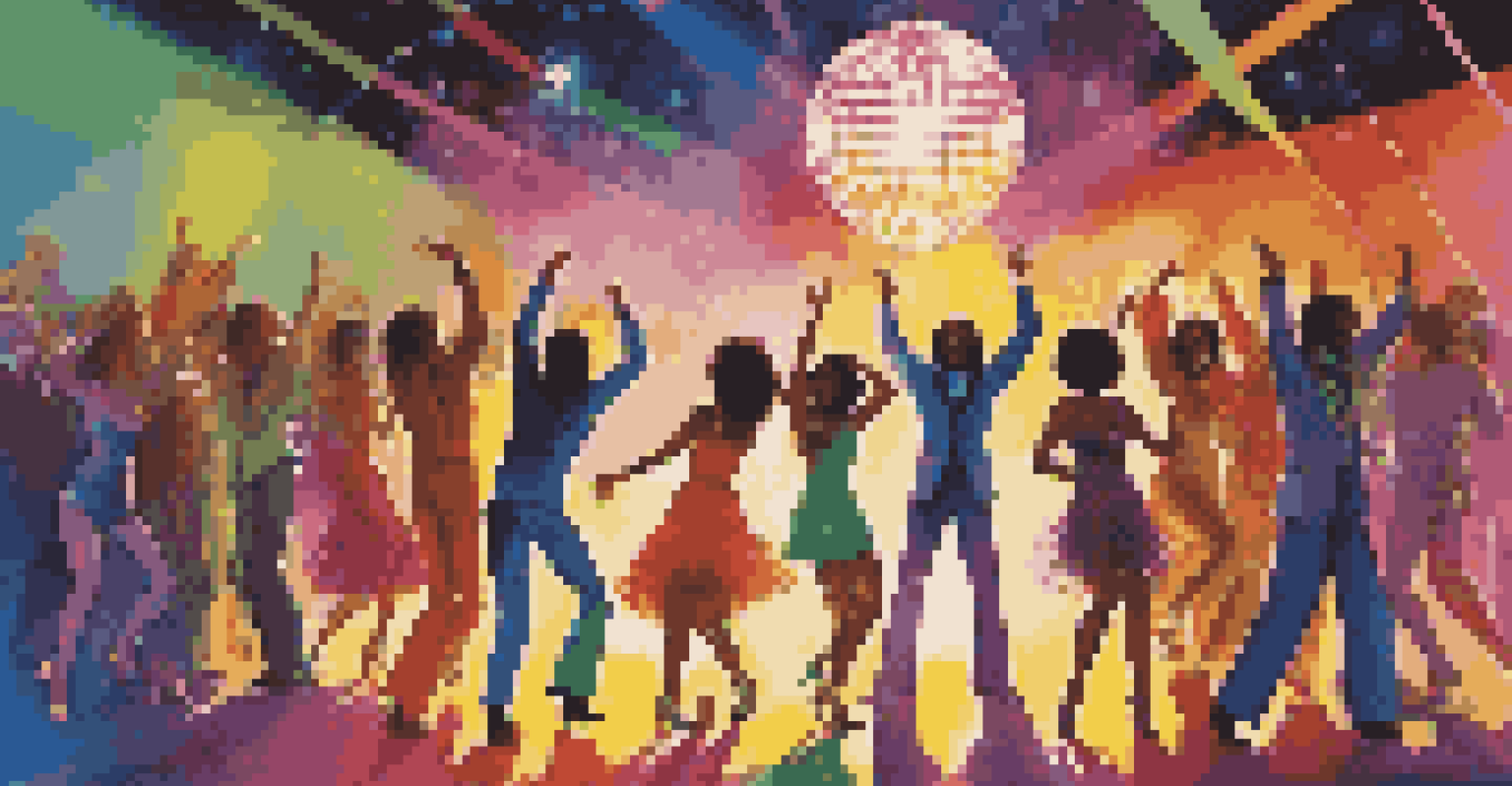The Influence of Pop Icons: Shaping Music Through Decades

Defining Pop Icons: What Makes Them Stand Out?
Pop icons are more than just talented musicians; they embody cultural movements and trends. With their unique styles and compelling narratives, they resonate deeply with audiences. Think of figures like Madonna or Michael Jackson, whose influence extended beyond music into fashion and social issues.
Music can change the world because it can change people.
These artists often challenge societal norms and inspire change, making them pivotal in shaping public perception. Their ability to connect with fans on an emotional level creates a sense of community and belonging. This powerful bond is what solidifies their status as icons.
In essence, pop icons serve as mirrors reflecting the values and aspirations of their time. Their artistry, charisma, and activism have a profound impact on music and society, leaving a lasting legacy that continues to inspire new generations.
The 1960s: The Birth of Modern Pop Icons
The 1960s marked a revolutionary period in music, introducing us to legends like The Beatles and Janis Joplin. These artists not only redefined musical styles but also influenced fashion, social movements, and youth culture. The Beatles, for example, transformed the music scene with their innovative songwriting and experimental sounds.

This decade also saw the rise of counterculture, with music becoming an anthem for change. Artists like Bob Dylan used their platforms to advocate for civil rights and anti-war sentiments. Their songs became synonymous with the struggles and hopes of a generation.
Pop Icons Reflect Cultural Values
Pop icons serve as cultural mirrors, influencing societal norms and inspiring change through their artistry and activism.
As the 1960s progressed, the emergence of pop icons signaled a shift in how music could unite people across diverse backgrounds. This era set the stage for future artists to embrace both their artistic and social responsibilities, establishing a legacy of influence that persists today.
The 1970s: Glitz, Glam, and Groundbreaking Sounds
The 1970s ushered in a new wave of pop icons who embraced flamboyance and innovation, such as David Bowie and Elton John. Their theatrical styles and daring performances captivated audiences, pushing the boundaries of what pop music could be. With their unique personas, they created a sense of escapism that resonated during a tumultuous time.
The power of pop music is that it can unite people and create a sense of community.
This decade also saw the rise of disco, with artists like Donna Summer and the Bee Gees dominating the charts. Disco culture not only influenced music but also fashion and nightlife, creating a vibrant scene that celebrated diversity and self-expression. The infectious beats and danceable tunes united people on the dance floor.
As pop icons of the 1970s broke down barriers and challenged conventions, they paved the way for future generations of artists. Their contributions to music and culture showcased the power of creativity and self-acceptance, leaving an indelible mark on the industry.
The 1980s: The Era of MTV and Iconic Superstars
The 1980s revolutionized music with the launch of MTV, which changed how artists connected with their fans. Icons like Michael Jackson and Madonna used music videos to enhance their artistic expression, creating memorable visuals that captivated audiences. Jackson's 'Thriller' became a cultural phenomenon, blending music and storytelling like never before.
This decade also highlighted the emergence of new genres, including hip-hop and synth-pop. Artists like Prince and Run-D.M.C. pushed the boundaries of music, experimenting with sounds and styles that reflected the changing landscape of society. Their fearless approach to creativity inspired countless artists to explore their own identities.
Decades of Musical Evolution
From the revolutionary 1960s to the digital 2000s, each decade introduced new pop icons who reshaped music and youth culture.
As the 1980s progressed, pop icons became symbols of empowerment and individuality. They not only entertained but also encouraged fans to embrace their uniqueness, fostering a sense of freedom and self-expression that resonated deeply in the hearts of many.
The 1990s: Diversity and the Rise of New Genres
The 1990s were marked by an explosion of musical diversity, with pop icons like Britney Spears and Tupac Shakur redefining the industry. This era saw a blend of genres, from pop and hip-hop to grunge and R&B, showcasing a rich tapestry of sounds that appealed to various audiences. Artists began to explore personal narratives and social issues, adding depth to their music.
The emergence of boy bands and girl groups, such as *NSYNC and Spice Girls, created a new wave of fan culture. These groups not only dominated the charts but also influenced fashion and youth culture, becoming icons in their own right. Their catchy hooks and synchronized dance moves made them household names, leaving a lasting impact on pop music.
As the decade drew to a close, the influence of pop icons was clear. They had not only transformed the music landscape but also shaped societal conversations around identity, race, and gender, proving that music could be a powerful tool for change.
The 2000s: Digital Revolution and Global Icons
The 2000s ushered in the digital revolution, changing how music was consumed and marketed. Pop icons like Beyoncé and Eminem emerged as global superstars, using the internet to connect with fans worldwide. This shift allowed artists to have more control over their careers, leading to innovative ways of engaging with audiences.
This era also saw the rise of social media, which transformed the relationship between artists and fans. Platforms like MySpace and later Instagram allowed pop icons to showcase their personalities and share their lives beyond music. This transparency fostered a deeper connection, making fans feel more involved in their favorite artists' journeys.
Future of Pop: Authenticity & Tech
Emerging artists like Billie Eilish and Lil Nas X are redefining pop with their authentic messages and leveraging technology for broader influence.
As pop icons of the 2000s embraced technology and globalization, they expanded their influence beyond music. They became cultural ambassadors, advocating for social issues and inspiring change on a global scale, ultimately shaping the future of the industry.
The 2010s: Authenticity and the Power of Streaming
The 2010s emphasized authenticity and relatability in pop music, with artists like Taylor Swift and Ed Sheeran leading the charge. As streaming platforms gained popularity, musicians began to focus on storytelling and personal experiences in their songs. This shift allowed fans to connect with artists on a more intimate level, fostering loyalty and engagement.
This decade also witnessed the rise of genre-blending, with artists incorporating elements from various musical styles. This experimentation led to fresh sounds and collaborations that challenged traditional norms. For instance, the collaboration between hip-hop and pop artists created chart-topping hits that appealed to diverse audiences.

As pop icons navigated the complexities of fame in the digital age, they became advocates for mental health and social justice. Their willingness to share personal struggles and champion important causes resonated with fans, reinforcing the idea that music can be a powerful vehicle for change and empowerment.
The Future: Emerging Icons and Evolving Influence
As we look to the future, emerging artists like Billie Eilish and Lil Nas X are redefining what it means to be a pop icon. They challenge conventional norms and embrace authenticity, resonating with a generation that values transparency and inclusivity. Their unique sounds and bold messages reflect the diverse landscape of modern music.
The influence of technology continues to shape the music industry, with platforms like TikTok driving trends and launching new stars. This shift allows for rapid discovery and gives a voice to underrepresented artists, creating a more dynamic and diverse musical landscape. Emerging icons are leveraging these platforms to engage with fans in innovative ways.
Ultimately, the legacy of pop icons will persist as they continue to shape music and culture. Their ability to adapt to changing times while remaining true to themselves ensures that the influence of pop icons will endure for decades to come, inspiring new generations of musicians and fans alike.